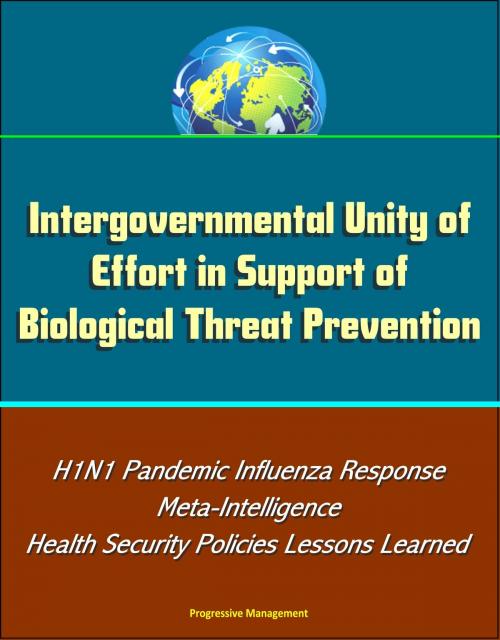Intergovernmental Unity of Effort in Support of Biological Threat Prevention: H1N1 Pandemic Influenza Response, Meta-Intelligence, Health Security Policies Lessons Learned
Nonfiction, Social & Cultural Studies, Political Science| Author: | Progressive Management | ISBN: | 9781310529764 |
| Publisher: | Progressive Management | Publication: | July 10, 2014 |
| Imprint: | Smashwords Edition | Language: | English |
| Author: | Progressive Management |
| ISBN: | 9781310529764 |
| Publisher: | Progressive Management |
| Publication: | July 10, 2014 |
| Imprint: | Smashwords Edition |
| Language: | English |
The purpose of this study is to examine ways to prevent the terrorist use of a biological weapon of mass destruction. Intelligence sources from around the globe report that terrorist groups are developing the capability and the intention to deliver biological weapons of mass destruction. Four coalitions of governments were studied to examine stated health security policies and reported outcome of a large biological threat incident of H1N1 global pandemic influenza of 2009-2010. It details the results and proposed methods to enhance intergovernmental connectivity and information sharing to prevent a biological threat.
CHAPTER I - INTRODUCTION * A. PROBLEM STATEMENT * B. BACKGROUND * 1. Latency Time Period * 2. U.S. Biological Threat Approach "Right of Boom" * 3. Strategic Pre-Incident Medical Intelligence Framework * 4. Time: A Non-Renewable Biodefense Resource * 5. Status Quo Biological Threat Political Paradigm * C. RESEARCH QUESTION * D. SIGNIFICANCE OF RESEARCH * 1. Prevention of a Biological Weapon of Mass Destruction * 2. Medical Intelligence in Support of Biodefense * 3. Literature * E. LITERATURE REVIEW * 1. Emerging Threat Assessment and Vulnerability of a Biological Attack * 2. History and Description of U.S. Medical Intelligence * 3. Medical Intelligence Product Requirements and Foreign Focus * 4. U.S. Medical Intelligence and Countermeasures in the Public Health System * 5. Treaty Rights, Sovereignty and Trust Responsibility * 6. Conclusion * F. METHOD * 1. Research Investigation Motivations * 2. Data Sample * 3. Data Collection * CHAPTER II - HEALTH SECURITY PREVENTION OF BIOLOGICAL WEAPON OF MASS DESTRUCTION . * A. Q1 METHOD * 1. Step 1a * 2. Step 1b * B. Q1 ANALYSIS * C. Q1 KEY FINDINGS * 1. Key Findings * 2. Patterns and Trends * CHAPTER III - HEALTH SECURITY POLICY BIOLOGICAL THREAT PREVENTION TRANSNATIONAL COMPARISON * A. Q2 METHOD * 1. Step 2a * 2. Step 2b * B. Q2 ANALYSIS * C. Q2 FINDINGS * 1. Key Findings * 2. Patterns and Trends * CHAPTER IV - H1N1 GLOBAL PANDEMIC BIOLOGICAL THREAT PREVENTION ACTIONS * A. Q3 METHOD * 1. Step 3a * 2. Step 3b * B. Q3 ANALYSIS * 1. H1N1 Biological Threat Approach Results * C. Q3 FINDINGS * 1. Key Findings * 2. Patterns and Trends * CHAPTER V - H1N1 GLOBAL PANDEMIC BIOLOGICAL THREAT PREVENTION TRANSNATIONAL COMPARISON * A. Q4 METHOD * 1. Step 4a * 2. Step 4b * B. Q4 ANALYSIS * C. Q4 FINDINGS * 1. Key Findings * 2. Patterns and Trends * CHAPTER VI - PERIOD OF PREVENTION TIME IN HEALTH SECURITY POLICY AND H1N1 GLOBAL BIOLOGICAL THREAT TRANSNATIONAL COMPARISON * A. Q5 METHOD * 1. Step 5 * 2. Step 5a * 3. Step 5a Difference Calculation (DC) * 4. Step 5b * B. Q5 RESULTS * C. Q5 FINDINGS AND ANALYSIS * 1. Key Findings * 2. 5c: Prevention Time Period Gap * 3. Patterns and Trends * CHAPTER VII - LESSONS LEARNED FROM INTERGOVERNMENTAL COALITIONS TO ENHANCE U.S. APPROACH TO BIOLOGICAL THREAT PREVENTION * A. LANGUAGE AND INTERGOVERNMENTAL UNITY OF EFFORT FOR THREAT REDUCTION. * 1. Homeland Security Challenge * 2. Opportunity * 3. Data and Discussion * B. INTERGOVERNMENTAL AND MULTI-JURISDICTIONAL UNITY OF EFFORT * C. META-LEADERSHIP MODEL AND INTERGOVERNMENTAL UNITY OF EFFORT * 1. Meta-Leadership Potential to Impact Intergovernmental Connectivity * 2. Challenges of the Meta-leader * 3. Recommendation * D. LATERAL LEADERSHIP, INFORMATION SHARING AND THE TIME PERIOD OF PREVENTION * 1. Homeland Security Challenge * 2. Opportunity * 3. Data and Discussion * CHAPTER VIII - EUROPEAN UNION MEDICAL INTELLIGENCE MODEL * A. EUROPEAN UNION STRUCTURE AND HEALTH SECURITY OPERATIONAL LEADERSHIP MODEL AND INTERGOVERNMENTAL INFORMATION SHARING MECHANISM * 1. Information Sharing Approach to Increase Shared Situational Awareness (SSA) * 2. Isolated Span of Control to Integrated Sphere of Influence * B. SYSTEM OF INTERGOVERNMENTAL TRANSNATIONAL LIAISONS AND LATERAL LEADERSHIP MODEL OF THE EU SPHERE OF INFLUENCE * CHAPTER IX - U.S. TRIBAL NATIONS MEDICAL INTELLIGENCE MODEL
The purpose of this study is to examine ways to prevent the terrorist use of a biological weapon of mass destruction. Intelligence sources from around the globe report that terrorist groups are developing the capability and the intention to deliver biological weapons of mass destruction. Four coalitions of governments were studied to examine stated health security policies and reported outcome of a large biological threat incident of H1N1 global pandemic influenza of 2009-2010. It details the results and proposed methods to enhance intergovernmental connectivity and information sharing to prevent a biological threat.
CHAPTER I - INTRODUCTION * A. PROBLEM STATEMENT * B. BACKGROUND * 1. Latency Time Period * 2. U.S. Biological Threat Approach "Right of Boom" * 3. Strategic Pre-Incident Medical Intelligence Framework * 4. Time: A Non-Renewable Biodefense Resource * 5. Status Quo Biological Threat Political Paradigm * C. RESEARCH QUESTION * D. SIGNIFICANCE OF RESEARCH * 1. Prevention of a Biological Weapon of Mass Destruction * 2. Medical Intelligence in Support of Biodefense * 3. Literature * E. LITERATURE REVIEW * 1. Emerging Threat Assessment and Vulnerability of a Biological Attack * 2. History and Description of U.S. Medical Intelligence * 3. Medical Intelligence Product Requirements and Foreign Focus * 4. U.S. Medical Intelligence and Countermeasures in the Public Health System * 5. Treaty Rights, Sovereignty and Trust Responsibility * 6. Conclusion * F. METHOD * 1. Research Investigation Motivations * 2. Data Sample * 3. Data Collection * CHAPTER II - HEALTH SECURITY PREVENTION OF BIOLOGICAL WEAPON OF MASS DESTRUCTION . * A. Q1 METHOD * 1. Step 1a * 2. Step 1b * B. Q1 ANALYSIS * C. Q1 KEY FINDINGS * 1. Key Findings * 2. Patterns and Trends * CHAPTER III - HEALTH SECURITY POLICY BIOLOGICAL THREAT PREVENTION TRANSNATIONAL COMPARISON * A. Q2 METHOD * 1. Step 2a * 2. Step 2b * B. Q2 ANALYSIS * C. Q2 FINDINGS * 1. Key Findings * 2. Patterns and Trends * CHAPTER IV - H1N1 GLOBAL PANDEMIC BIOLOGICAL THREAT PREVENTION ACTIONS * A. Q3 METHOD * 1. Step 3a * 2. Step 3b * B. Q3 ANALYSIS * 1. H1N1 Biological Threat Approach Results * C. Q3 FINDINGS * 1. Key Findings * 2. Patterns and Trends * CHAPTER V - H1N1 GLOBAL PANDEMIC BIOLOGICAL THREAT PREVENTION TRANSNATIONAL COMPARISON * A. Q4 METHOD * 1. Step 4a * 2. Step 4b * B. Q4 ANALYSIS * C. Q4 FINDINGS * 1. Key Findings * 2. Patterns and Trends * CHAPTER VI - PERIOD OF PREVENTION TIME IN HEALTH SECURITY POLICY AND H1N1 GLOBAL BIOLOGICAL THREAT TRANSNATIONAL COMPARISON * A. Q5 METHOD * 1. Step 5 * 2. Step 5a * 3. Step 5a Difference Calculation (DC) * 4. Step 5b * B. Q5 RESULTS * C. Q5 FINDINGS AND ANALYSIS * 1. Key Findings * 2. 5c: Prevention Time Period Gap * 3. Patterns and Trends * CHAPTER VII - LESSONS LEARNED FROM INTERGOVERNMENTAL COALITIONS TO ENHANCE U.S. APPROACH TO BIOLOGICAL THREAT PREVENTION * A. LANGUAGE AND INTERGOVERNMENTAL UNITY OF EFFORT FOR THREAT REDUCTION. * 1. Homeland Security Challenge * 2. Opportunity * 3. Data and Discussion * B. INTERGOVERNMENTAL AND MULTI-JURISDICTIONAL UNITY OF EFFORT * C. META-LEADERSHIP MODEL AND INTERGOVERNMENTAL UNITY OF EFFORT * 1. Meta-Leadership Potential to Impact Intergovernmental Connectivity * 2. Challenges of the Meta-leader * 3. Recommendation * D. LATERAL LEADERSHIP, INFORMATION SHARING AND THE TIME PERIOD OF PREVENTION * 1. Homeland Security Challenge * 2. Opportunity * 3. Data and Discussion * CHAPTER VIII - EUROPEAN UNION MEDICAL INTELLIGENCE MODEL * A. EUROPEAN UNION STRUCTURE AND HEALTH SECURITY OPERATIONAL LEADERSHIP MODEL AND INTERGOVERNMENTAL INFORMATION SHARING MECHANISM * 1. Information Sharing Approach to Increase Shared Situational Awareness (SSA) * 2. Isolated Span of Control to Integrated Sphere of Influence * B. SYSTEM OF INTERGOVERNMENTAL TRANSNATIONAL LIAISONS AND LATERAL LEADERSHIP MODEL OF THE EU SPHERE OF INFLUENCE * CHAPTER IX - U.S. TRIBAL NATIONS MEDICAL INTELLIGENCE MODEL















